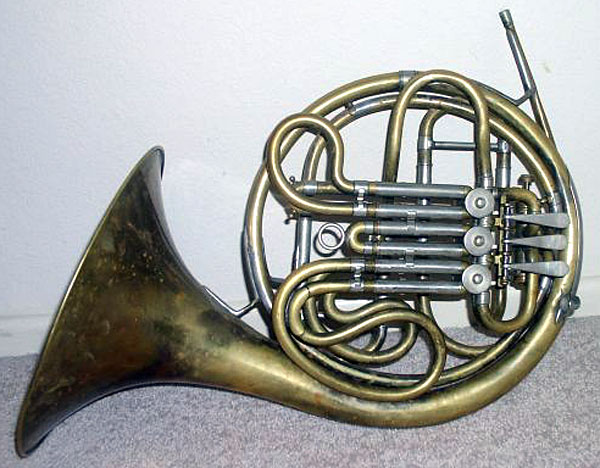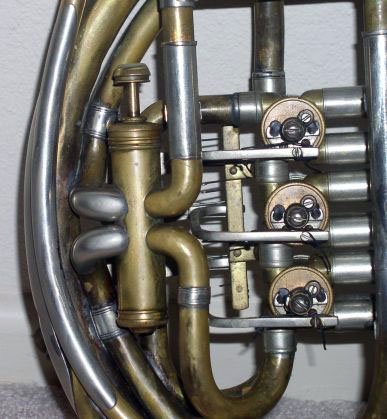Conn 6D New Wonder F-Bb Double French Horn


Date: 1934. Owned by Leonard Brown, DM (HC)
This model 6D, produced from at least 1919 to 1935, was called the "Schmidt" model. I read on eBay that the term "Schmidt model" comes from the fact that the design was essentially copied from a German horn built by C. F. Schmidt, who had workshops in Weimar and Berlin. The distinguishing feature is the piston change valve for F-Bb, which can be seen behind the rotary valves in the drawing above. The "Schmidt" 6D was available with or without stop valve. The instrument had to be ordered with or without the stop valve from the factory. The instrument pictured here doesn't appear to have such a stop valve.
The owner of this French horn tells me the 6D "Schmidt" model "is different than the original Schmidts in that the bore is slightly large, the pipes have been switched on the F tuning slide and the piston valve is different. 1934 was the last year for this model and by this time Conn had changed the piston valve making the ports closer together and thus making the valve shorter. This is much more comfortable to play than the Schmidts because of this. Both Schmidt and Conn used the same valve maker in Germany at the time. Older Conns are marked, "Made in Germany" but that is only the valves, not the instrument."
What Conn said in 1924:
Probably no other instrument imposes the manufacturing problem which is found in the French horn, for none
other contains such a length of tubing in such a small bore. Even slight variations in the tubing mean endless
difficulty for the performer, and the French horn has for this reason been considered one of the most troublesome
instruments to master. The manufacturing problem has been solved, however, in the Conn factories, for by means of
the expansion process the long tubes are shaped with absolute accuracy. There can be no variation, however slight,
in Conn French horns; there is no handicap which the performer must overcome. The consequent ease of playing has
made Conn horns highly desirable, and they are greatly in demand by the highest class artists.
(...) [T]he model shown here may be equipped with the tuning slide shown in the small photo, which enables the
performer to correct the tune of his instrument which is sharpened when the hand is forced into the bell. It also
gives an A horn with the Bb , and an E with the F. This tuning slide can be supplied only with the horn for which
it is intended, and there is an extra charge for the attachment.
What Conn said in 1934:
The 6D double horn is the favorite with big symphony players, and particularly first chair men. It is built in F but
a length of tubing can be cut off by operating a piston valve, which throws the horn into Bb. This feature enables
the player to select his horn to advantage for different key signatures and also gives the performer more open notes,
which gives a richer and more uniform tonal coloring. For instance, C, D, E in the staff are open on the F horn, while
F and G are open on the Bb horn, A is open on the F horn. By having the double horn the scale from C to A can be played
open. The scale is exceptionally fine and it blows with surprising ease, due to Hydraulic Expansion and the elimination
of all sharp bends in tubing. The mouthpipe, one of the most critical spots in a horn, was selected unanimously by big
symphony players from among 14 experimental mouthpipes. Much experimenting was also done with the bell and bell branch.
These have a great deal to do with the response of the French horn. Used by such outstanding artists as Max Pottag,
Chicago Symphony. Rotary valves are used except for cut-off which is a piston valve conveniently located for thumb of
left hand. Piston valve elimintates several sharp bends necessary where rotary is used.